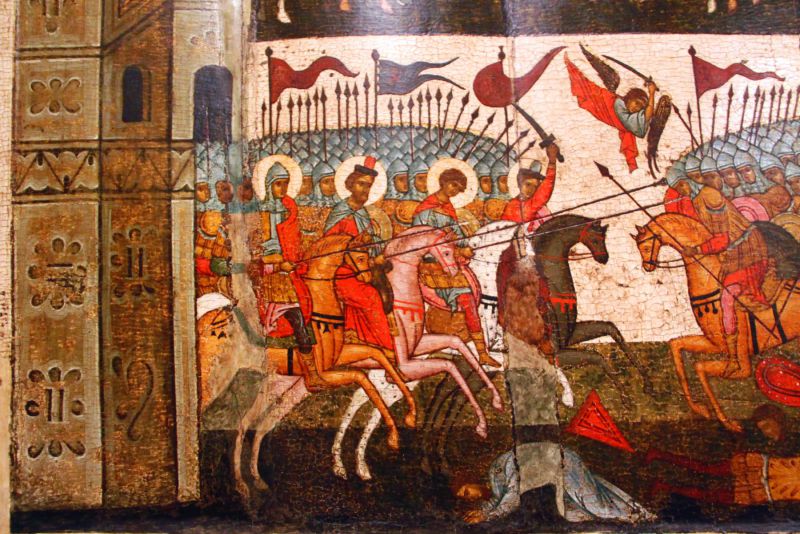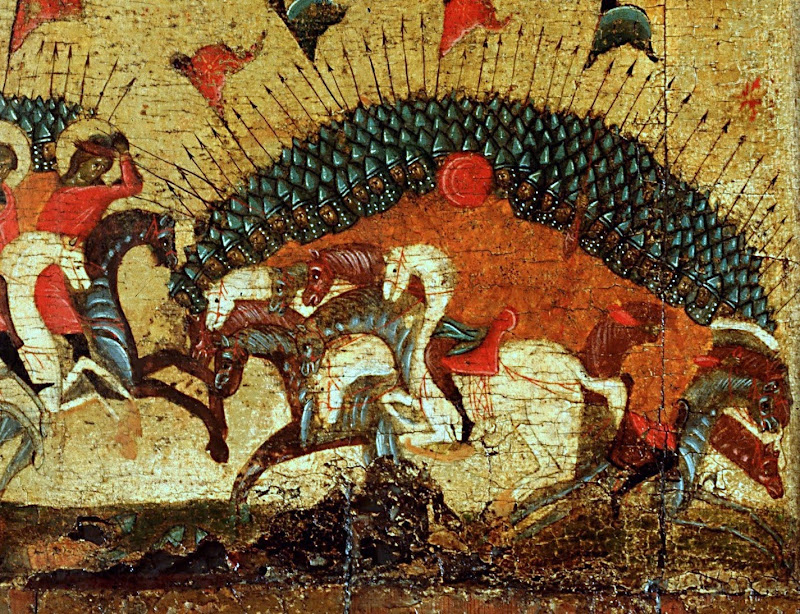What a saint's beard (or lack thereof) symbolizes, how to discover the outcome of battles portrayed on icons, and what strange hybrid animals with halos actually represent
This is the continuation of our guide on how to "read" the Russian icon which reveals a few more whimsical secrets. For instance, what a man's beard (or lack thereof) symbolizes, how to discover the outcome of battles portrayed on icons, and what strange hybrid animals with halos actually represent.
In Russia, the first art to appear and flower was religious art, or iconography. Icons, or religious paintings and frescoes comprised a key into the spiritual realm; they carried a deep and subtle theology through images. Through them, Christian stories and teachings became accessible even to those who couldn’t read. Icons still weave narratives and communicate ideas through colours, perspective, size and much else.

(For part 1, which explains the significance of colors, perspective and dimension in the icon, read The Amazing Religious Tradition that Gave Birth to Russian Art)
What the presence or absence of a beard can tell you about a saint
In ancient Russia, a beard was considered the most important attribute of a grown man. “Beardshaving” was condemned as a sin, for medieval Russians could not conceive that a man might willingly alter the image of God.
Their logic was simple: Christ wore a beard and the Creator rewarded men with a beard for a reason. In shaving a beard, a man thus deprived himself of an important sign of strength and masculinity.

Not surprisingly, almost all holy men were depicted on the icons with beards. The absence of a beard on a saint usually symbolises young age.
The lack or presence of a beard becomes especially useful for establishing the identities of brother-saints on icons. Only with the help of the beard, one can immediately differentiate the elder from the younger brother; their faces are typically otherwise identical.

For example, the princes Boris and Gleb, who were killed by an order of their malicious brother, can be easily distinguished from each other precisely on this basis: the younger one, Gleb, unlike the older Boris, does not wear a beard. The same holds true for the holy brothers Flor and Laurus, greatly celebrated in the Russian land.

Ethereal spirits, angels and demons, of course, have no gender, and, accordingly, they should not have facial hair. But the devil sometimes has a beard. This is a sign of hierarchical supremacy: like a full-face spread or larger, a beard allows you to distinguish the devil in the underworld or to distinguish the leader from the surrounding simple demons.
How the banners reveal the outcome of the battle

Many ancient Russian icons and miniatures depict the battles and combat, in which people believed the outcome was decided by God’s interference. Troops attack and retreat, spears are raised above the heads of the soldiers and banners of different shapes and colors flutter above everything else.
Paying attention to the banners flying above the troops, however, reveals the direction in which the the armies are moving . Without them, it would be impossible to identify which army will emerge victorious. Through them one discovers which of the colliding troops will be graced with victory: the banners of the losers are turned back, indicating their future flight from the battlefield.

Tetramorphs, or Strange Beasts with Halos
Church frescoes and icons often display images of a calf, a lion and an eagle adorned with halos. A fourth character appears next to the animals, a winged being who looks like an angel.

These figures originate in Biblical texts. The vision of the prophet Ezekiel tells of tetramorphs, or fantastic beasts that looked like four earthly creatures simultaneously: each one had the faces of man, lion, calf and eagle as well as four wings. Later, the four beasts with the same faces, but as separate entities, are mentioned in the Revelation of the Apostle John, in the Apocalypse:
“..And before the throne there was a sea of glass like unto crystal: and in the midst of the throne, and round about the throne, were four beasts full of eyes before and behind.

And the first beast was like a lion, and the second beast like a calf, and the third beast had a face as a man, and the fourth beast was like a flying eagle.
And the four beasts had each of them six wings about him; and they were full of eyes within: and they rest not day and night, saying, Holy, holy, holy, Lord God Almighty, which was, and is, and is to come.” Revelation 4: 6–8
As early as 200 AD, Christian theologians began to associate these animals with the four apostles-evangelists.

The most popular interpretation first in Europe, and then in Russia, became the explanation of St. Jerome. He analysed fragments of the four Gospels to argue that the man symbolises Matthew, the lion—Mark (hence the winged lion on the column of St. Mark’s Square in Venice), Luke—the calf, and the eagle represents John.


In the 7th century, Pope Gregory the Great wrote that the four beasts also symbolise Christ himself, who was born as a man, accepted death as a sacrificial calf, when resurrected He was like a lion and ascended to the heavens as an eagle.

Take action! Resist the assault from the rainbow mafia:
